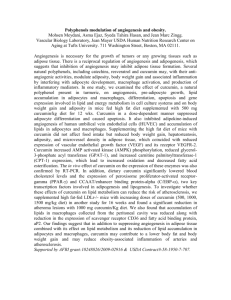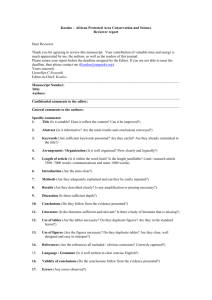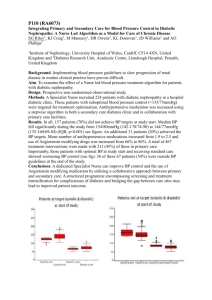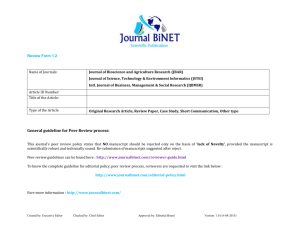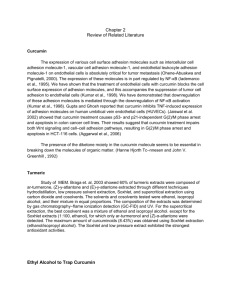Response to Reviewers
advertisement
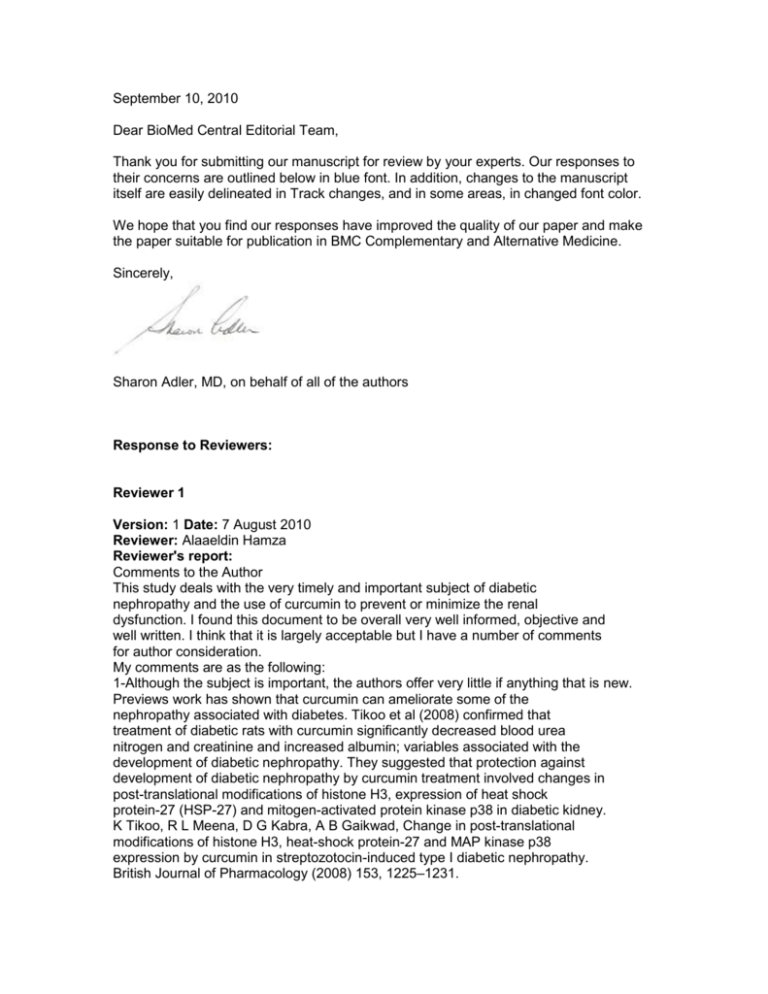
September 10, 2010 Dear BioMed Central Editorial Team, Thank you for submitting our manuscript for review by your experts. Our responses to their concerns are outlined below in blue font. In addition, changes to the manuscript itself are easily delineated in Track changes, and in some areas, in changed font color. We hope that you find our responses have improved the quality of our paper and make the paper suitable for publication in BMC Complementary and Alternative Medicine. Sincerely, Sharon Adler, MD, on behalf of all of the authors Response to Reviewers: Reviewer 1 Version: 1 Date: 7 August 2010 Reviewer: Alaaeldin Hamza Reviewer's report: Comments to the Author This study deals with the very timely and important subject of diabetic nephropathy and the use of curcumin to prevent or minimize the renal dysfunction. I found this document to be overall very well informed, objective and well written. I think that it is largely acceptable but I have a number of comments for author consideration. My comments are as the following: 1-Although the subject is important, the authors offer very little if anything that is new. Previews work has shown that curcumin can ameliorate some of the nephropathy associated with diabetes. Tikoo et al (2008) confirmed that treatment of diabetic rats with curcumin significantly decreased blood urea nitrogen and creatinine and increased albumin; variables associated with the development of diabetic nephropathy. They suggested that protection against development of diabetic nephropathy by curcumin treatment involved changes in post-translational modifications of histone H3, expression of heat shock protein-27 (HSP-27) and mitogen-activated protein kinase p38 in diabetic kidney. K Tikoo, R L Meena, D G Kabra, A B Gaikwad, Change in post-translational modifications of histone H3, heat-shock protein-27 and MAP kinase p38 expression by curcumin in streptozotocin-induced type I diabetic nephropathy. British Journal of Pharmacology (2008) 153, 1225–1231. We believe that the Reviewer has missed the point if the conclusion is that “very little if anything is new” in this paper. All other published papers show a purported benefit for curcumin in diabetic nephropathy. We point out shortcomings in the experimental approaches of these previously published works, raising some doubt regarding their conclusions, and then show, that at least in this mouse model, curcumin did not attenuate the cardinal manifestation of early diabetic nephropathy, albuminuria. In addition, the use of timed urine collections for HPLC measurements of urine curcuminoid/creatinine ratios to quantify curcumin bioavailability represents a completely novel aspect of this work. Our paper urges a healthy skepticism concerning the benefit reported by others. As nephrologists, it is our position that the published parameters used by other authors to study curcumin in diabetic nephropathy were frequently inadequate. One novel aspect of our paper is that we used criteria for the diagnosis of diabetic nephropathy in mice that would be used in patients. By these criteria, these mice did not benefit. We would hope that publication bias would not prevent publication of this negative, but significant result because, in fact, it IS different than the published literature on this topic to date. 2- The second concern is the dose of curcumin in animal study. The authors fed mice at dosage 5000 ppm amd 7500 ppm which have been used in mouse model of Alzheimer disease. I think these doses are too low to induce effect in diabetic mice. Chiu et.al. (2009) found that curcumin at dosage level 150mg/kg was effective to prevent diabetesassociated abnormalities in kidney of rats. In another study, 75 mg•kg–1•day–1curcumin ameliorated renal failure in mice. Suresh Babu1 and Srinivasan (1998) fed rats with curumin (0.5% in the diet) to ameliorate renal lesion in diabetic rats. The Reviewer believes that we did not see an effect because the dose that we chose was too low. We are not in agreement with the Reviewer concerning this point for the following reasons: 1). We chose doses that were high enough to show benefit for curcumin in another disease model, e.g. Alzheimer disease. 2) We obtained curcumin from the same source as the Alzheimer study. 3) We used the same compounder to make the mouse food. 4) We demonstrated by collecting urine and making HPLC measurements that curcumin and curcuminoid were present in urine, thereby demonstrating pharmacodynamically that the target organ (eg the kidney) was exposed to drug. The latter is actually unique in this field, since no other study has demonstrated this. 5) We demonstrated other biological effects of the administered curcumin on the kidney (eg a decrement in renal cortical HSP25 and an increase in urine 12-HETE excretion). 6) In the paper by Babu and Srinivasan (Mol Cell Biochem 1811-2): 87-96, 1998) to which the Reviewer refers above, the dose of 0.5% that was administered is equivalent to 5000 ppm, which is the lower of the 2 doses that we administered. Therefore, there is abundant evidence that the curcumin that was given actually reached the target organ and was administered was present in sufficient quantity to achieve other biological responses at the target organ. It nevertheless did not reduce albuminuria. However, we agree with the Reviewer that under other conditions and possibly at an even higher dose, this therapy may have been more effective. In fact, the manuscript already acknowledges this in the last paragraph, which states: “While strain, species, and dosing issues may be responsible for this negative result, the biological responses of HSP25 and 12/15-LO to curcumin may underlie this failure. Thus, despite encouraging in vitro effects, these data do not confirm prior published in vivo work and suggest that curcumin is not universally useful in ameliorating DN”. Note that we did not state that curcumin does not work under any condition. We do state, and we underscore, that the dose we gave was adequate to achieve other biological responses in the kidney, and that under these conditions, curcumin did not attenuate the key manifestation of diabetic nephropathy, albuminuria. References Chiu J, Khan ZA, Farhangkhoee H, Chakrabarti S. Nutrition. 2009 Sep;25(9):964-72. Curcumin prevents diabetes-associated abnormalities in the kidneys by inhibiting p300 and nuclear factor-kappaB. P. Suresh Babu1 and K. Srinivasan (1998).Amelioration of renal lesions associated with diabetes by dietary curcumin in streptozotocin diabetic rats. Molecular and Cellular Biochemistry, 181, (1-2) 3-The paper is quit long, this is uncomfortably large for many people. I would like you omit any non-essential materials from conclusion. We went through the text and tried to shorten where we could. 4- Figure 5 needs to represented, the data of blood glucose, changes in body weight and food intake must be added in table. The data on food intake/4 days is already shown in Figure 5, and a tabular form would probably be redundant. We removed the blood glucose values from the text and now display them as a Table added to Figure 3. We do not have the body weights. Level of interest: An article of importance in its field Quality of written English: Acceptable Statistical review: Yes, but I do not feel adequately qualified to assess the statistics. Reviewer 2. Version: 1 Date: 17 August 2010 Reviewer: Sae kwang Ku With all due respect, the authors refute the allegation of the Reviewer that the manuscript cannot be understood due to grammatical errors. In fact, it is this review, and not the paper, that is written with grammatical errors that obfuscate. Indeed, I had difficulty in understanding some of the comments of this Reviewer due to this problem, and therefore could address most, but not all, of the comments. Reviewer's report: This manuscript presents results of a study designed to examine the ability Curcumin to the podocyte p38MAPK-HSP pathway in vitro. However, author(s) did not revealed any favorable effects on streptozotocin-induced diabetic nephropathy in vivo. This reviewer concluded as “Major Compulsory Revisions (which the author must respond to before a decision on publication can be reached)” Despite the potential interest of this manuscript to the field, it is not possible to provide an adequate review of the manuscript in its current form due to the number of grammatical errors and some results are difficult to understanding. The author(s) are encouraged to describe or answers as following questions Major comment: Why used streptozotocin-induced diabetic nephropathy in vivo only. There are numerous other nephropathy animal models; Before concluded Curcumin did not attenuate streptozotocin-induced diabetic nephropathy, author(s) should be test on other animal models, especially STZ-induced Rats or db/db mice. In addition, it seems to be need more detail explains on the Material and methods. The authors agree that the study of additional models of diabetic nephropathy would have been ideal. However at this point, since the funds for the project have been completely expended, that is not an option. The use of streptozotocin for induction of diabetic nephropathy in the DBA2j mouse has been advocated by members of the National Institutes of Health-funded “mouse consortium” (Qi Z, Fujita H, Jin J, Davis LS, Wang Y, Fogo AB, Breyer MD: Characterization of Susceptibility of Inbred Mouse Strains to Diabetic Nephropathy. Diabetes 54:2628-2637, 2005). Indeed the divergent result in this animal model compared to the result in rats may reflect underlying differential responses to therapy based on strain/species. This has been stated clearly in the manuscript, and is worthwhile documenting. It is important to note that we did not “conclude that curcumin did not attenuate diabetic nephropathy” as the Reviewer stated above. In our conclusion, we stated that “these data do not confirm prior published in vivo work and suggest that curcumin is not universally useful in ameliorating DN”. Statistical Analysis This reviewer strongly suggest that used more sensitive statistical method such as ANOVA test, especially on In Vivo As stated in the Statistical analysis section, all the data were analyzed by ANOVA, followed by Student t test to discern within group differences. Details 1. Seems to be need to change the ‘in vitro, in vivo’ with Italic. As requested by the Reviewer, we have italicized “in vitro” and “in vivo”. 2. P3. Line 14. You said “previously showed in vitro that short-term incubation of podocytes in medium with a high glucose concentration resulted in phosphorylation of p38MAPK and downstream HSP25.” But we did not know when/where you said(quote the origin) and what time is short-term? We apologize regarding confusion concerning this reference. Our work is described not only in the sentence to which the Reviewer refers, but continuously in the next 8 lines. The reference therefore is at the end of the sentence on the eighth line, and is reference 18. I have removed references 5, 7, and 8 in this citation to eliminate any confusion. In the current manuscript referring to reference 18 alluded to above, the incubation time was inadvertently left out of the manuscript and we thank the Reviewer for pointing out this omission. The sentence in question has been corrected as follows: “We previously shown in vitro that short-term incubation of podocytes in medium with a high glucose concentration (up to 4 hours) resulted in phosphorylation of p38MAPK and downstream HSP25, associated with maintenance of the actin cytoskeleton. Incubation of podocytes in high glucose medium for as briefly as 4 hours with a p38MAPK inhibitor attenuated downstream HSP25 phosphorylation, inducing F- to G-actin cleavage, and cytoskeletal disruption”. 3. P4. Podocyte culture Podocyte culture: briefly write the method of ‘conditionally immortalized mouse podocytes’ It seems to be need to write the ‘thermosensitive SV 40 transgene’ method: what kind(gene sequence) of promoter, terminator and others did you use. And how do you check the transgene well-done. Reference 23 is use ‘100 U/ml of the #-IFN’ but you use ‘50 U/ml’, explain why the dose is difference. Reviewer 1 complained that the manuscript was too long, so we believe that the addition of the information requested by Reviewer 2 here will make the manuscript even longer, and is unnecessary. Reference 23 provides all of the information the Reviewer wishes. This cell line requires no additional validation. It is an extremely well established and accepted cell line for the study of podocyte biology. If one goes to Google Scholar and searches the name “Mundel” (referring to Peter Mundel, who developed the cell line) and “SV40 podocytes”, there are 342 hits. If one omits Mundel’s name in the search, there are 945 hits. The vast majority of those 945 hits are by investigators using the Mundel podocytes. This underscores how much these cells are utilized, and how well-known the cells are by investigators in the field of glomerular biology. The interested Alternative Medicine investigator can find the details regarding this cell line quite easily in the published literature. While the Reviewer’s comment concerning the interferon concentration in this reference is correct (Ref 23), the difference between the 50 and 100 U/ml concentration of interferon is not critical. For example, in the publication entitled “Podocyte expression of the CDK-inhibitor p57 during development and disease” published in Kidney International (2001) 60:2235–2246, which includes Mundel as an author, an interferon concentration of 50 U/ml was used, as was used in our submitted work. In order to address the Reviewer’s concerns, we added the words “with minor modifications” to cover this small difference. The sentence now reads: “Conditionally immortalized mouse podocytes (Pods), carrying a thermosensitive SV40 transgene, were obtained from Dr. Peter Mundel and cultured as described with minor modifications (23). Conditionally immortalized mouse podocytes (Pods), carrying a thermosensitive SV40 transgene, were obtained from Dr. Peter Mundel and cultured as described with minor modifications (23). Conditionally immortalized mouse podocytes (Pods), carrying a thermosensitive SV40 transgene, were obtained from Dr. Peter Mundel and cultured as described with minor modifications by Mundel et al (23)”. 4. P6. DNase 1 inhibition assay for the measurement of F/G actin ratio You could better changing number(24,25,18) to researchers’ name(blikstad I, papakonstanti EA, Dai T) We changed the sentence as follows: Pod F- and G-actin were measured using the methods of others (24, 25) and as previously utilized and reported by us (18). Need to write the full name of GA Thank you. We have changed GA to G-actin. 5. Experimental animals Need to write the detailed animal conditions (ages, donator or where do you purchased) Thank you. We added to the manuscript that the mice were purchased from Jackson Laboratories, Bar Harbor, Maine, USA, and that they weighed 20-22 gm and were 2 months old at the time of streptozotocin injection. For the collecting the podocyte you must to kill the animals, so have to write the anesthesia method and IRB name & approval number. The podocytes are a cell line, as discussed above and as stated in the paper. They were provided by Dr Peter Mundel (Ref 23), and no mice were killed to obtain podocytes. The mice, however, were killed to do the kidney tissue Western blots. The manuscript already states: “All animal studies were performed under a protocol approved by the Los Angeles Biomedical Research Institute Animal Use Committee”. Our IRB issues approval in the form of a letter to the investigator. There is no approval number. At the request of the Reviewer, we have now added that the mice were killed by exsanguination under general anesthesia. Discretionary revisions: When you added the materials in food, it may be difficult to control the same dosage (mg/kg body weight). We suggest you to administer the materials using gastric gavage (Zondae) for accurate dosage We agree with this comment, and considered this approach when we designed the project. Unfortunately, we did not have the expertise to perform gavage. 6. P7. In experimental I, you measured urine items on day 9 and 15. Why you measured on that day? And clear define the day of 9 and 15, define the day 1. Also in experiment 2, define the weeks 2, 4 and 7 Mice were injected with streptozotocin daily for 5 days. One week later, fasting blood glucose was measured to ascertain for diabetes. In Experiment 1, Days 9 and 15 refer to the number of days of confirmed diabetes. These days were chosen because they were the earliest time points at which we detected albuminuria. In Experiment 2, weeks 2, 4, and 7 refer to the number of weeks with confirmed diabetes. This clarification has been added to the manuscript. 7. P7. Numbers of animals in groups are different. Why do you have different number in your each group? And you measure the on 9 and 15 day but you did not write how many animal you kill on each days (9, 15) Some mice did not become diabetic after streptozotocin injections. Some mice died. 8. P8. The sentence ‘to determine ~ subsequent experiments’ previously, and it is seems to be as a repetition stationery I cannot understand this. 9. P8. The pods changes in cur 60-70 min stimulation but we don’t know what/how the podocytes changes. You need to write the detail changes. We eliminated the clause “and induced quantifiable biological changes in Pods” 10. P10. Line 3, check the DMcur0 value (2.8±07) and figure 3 does not indicate the 2.8 level Thank you. This was an error and is now corrected to read 2.23±07 in the text. Line 20. You wrote the measurement were made from 5-11weeks but you just on one time values which is don’t know what weeks values These were repeat measures during this time period. Mice were in steady state at this time, and their values did not differ from one week to the next, so the values were aggregated. line 9. You did high concentration cur food experiment cause by thinking low dosage. But we think many cause ex) short-period administration, nullified effect, irregular cur-administration etc (P.18). We originally intended the study to be carried out for at least 12 weeks. However, in Experiment 1, by nine days it was clear that the diabetic mice already had significant albuminuria, and that curcumin did not attenuate the albuminuria. Therefore, the study was short because there was no benefit, not the other way around. I do not know what you mean by nullified effect. I agree with the Reviewer’s comments that gavage would have provided a more stable dose and would have been the preferred method of drug delivery. Unfortunately, we did not have the technical expertise to do this. Instead, we have offered evidence that the drug was present at the target organ, and that it succeeded in inducing a biological effect there. Our HPLC measurements clearly show that curcuminoid was delivered to the kidney, and our Western analyses of kidney lysate show a biologic effect (low HSP25 and high urine 12-HETE/creatinine) of that curcuminoid in the kidney. Despite that, there was no attenuation of albuminuria. In my view, I believe that this may be a strain effect. As stated in the manuscript: “The burden of explaining why curcumin failed to ameliorate albuminuria in these mice remains, and one can only speculate. A unique response in this mouse strain cannot be ruled out, as it is well-appreciated that genetic backgrounds influence both disease susceptibility and response to treatments.” 11. P11. Line 23 how did you calculate ‘food intake was only ~50% higher’. In figure 5. I think the food intake volume is too much by a mouse. Sorry for the confusion. The Legend reads that the food intake was measured on Day 4, but omitted that the measurement reflected the food intake of the first four days of the protocol. This has now been clarified in the legend. Line 24,25, check the unit of creatinine ‘mcg’ “mcg” was intended to be micrograms. Sometimes when one uses a symbol, it is changed during pdf transformation or when viewed with a different version of WORD. A has been inserted in the text to replace mc as requested. 12. P12. Line 2. I think you collect the sample from the day 9 to 15 (during a week). If you do that, your samples have no consistency. Correctly explain when did you collect the renal sample. These were timed samples collected overnight on day 9 and day 15. Line 9. U 12-HETE/cr -> urinay 12-HETE/cr. Done. 13. P15. Line 3,9 You need to quote reference. I am not sure to what this refers. Line 23. You argued Babu et al did not analyze the histological changes. But you also did not offer the histological analysis (glomeruli histomorphometry etc) Our concern with Babu’s work is not that they failed to analyze histological change, but rather that they analyzed it poorly. As stated in the manuscript: “a description of how the histologic analyses were performed is lacking, and the photomicrographs provided are of very low magnification and not easily interpretable by the reader”. We did not perform histological evaluation because we already knew that the treatment did not work in our experimental mice based on the measured urine albumin/creatinine values. 14. P17. Line 15. (6,93,94)(95) -> (6,93-95) Thank you. We made this change. Level of interest: An article whose findings are important to those with closely related research interests Quality of written English: Acceptable Reviewer 3. Version: 1 Date: 18 August 2010 Reviewer: Kulbhushan Tikoo Reviewer's report: In the present study the authors had explored the potential of curcumin as a treatment regimen against diabetes mellitus (DM) both in vitro and in vivo. It is interesting study in a way as it raises doubts about other studies which shows protective role of curcumin in diabetic nephropathy. But before the acceptance of this manuscript, there are certain critical points to be addressed. Major revisions 1) My major concern is with the quality of the western blots. The blots shown in the manuscript are not from the single blot for different treatment groups. This makes it inconvenient to compare the results for different treatment groups and thus pose a question on the reliability of the data. Level of p38 and hsp25 in normal control animals should be included in figure 6. The Reviewer is correct regarding the Western blots. Unfortunately, there were too many samples, so the samples could not be run together on a single gel. With regard to the second, equally valid point, our limited goal in this experiment was to determine if curcumin had an effect on p38MAPK or HSP25 in diabetic mice. Therefore, we compared the results in diabetic mice who received dietary curcumin with diabetic mice who did not receive curcumin. Our goal was not to compare diabetic mice to nondiabetic mice, even though that would be of some interest as well. Unfortunately, although we would like to provide the Reviewer with this information, we no longer have cell lysate from these mice, and cannot do new blots, We also have no additional funding to support an entirely new set of mice for this purpose. 2) From the present results, it seems that curcumin at higher dose is actually increasing the plasma glucose level and urinary 12-HETE/cr excretion in vivo. The authors should explain the possible reason for the same in discussion. In Experiment 1, the fasting blood glucose measurements reported were taken one week after the last of five streptococci injections. The diets were initiated the next day. Therefore, in Experiment 1, the glucose measures did not reflect any influence of the diet. In Experiment 2, the diets were assigned one week prior to the start of the five daily streptozotocin injections, and the fasting blood glucose measurements were taken one week after the last of the five injections. Therefore, in Experiment 2, the glucose measurements did reflect the assigned diet. There was a statistically significant increment in fasting blood glucose in the mice getting curcumin in Experiment 2. This was noted for both the diabetic and the non-diabetic groups. Because of this difference, noted 1 week after the last Stz dose, we monitored the blood glucose at later time points, including in some mice who were kept for up to 11 weeks for the purpose alone. These values showed no difference. These data are now presented in tabular form as requested by the Reviewer. In addition, a statement has been added to acknowledge that early differences in glycemic control may have also contributed to the failure of curcumin to attenuate diabetic nephropathy in these mice. (“In addition, at lest in Experiment 2, fasting blood glucose was higher at week 1 in mice receiving curcumin, a finding that was not replicated in measures taken at later weeks. These early differences were statistically significant, but their biological significance is uncertain. Nevertheless, we cannot exclude that this apparently transient and relatively small increment in blood glucose early in disease development contributed to the lack of apparent efficacy of curcumin to attenuate albuminuria.” ) We have no explanation for this difference in glycemic control, and are aware (and cite in the paper) evidence by others of an opposite effect of curcumin on glycemic control after Stz injections. As the Reviewer points out, these data do show an increase in urine 12-HETE in the curcumin treated mice. Indeed, it is the belief of the authors that this increment may in part explain the deleterious impact of curcumin on albuminuria as detected under these experimental conditions. The Discussion section of the manuscript delves into this in some detail. (As stated, “Curcumin has been reported to inhibit lipoxygenases by one group of investigators (87), but was found to be a substrate of lipoxygenases by another group (88). Urine 12-HETE is a reliable measure of activation of the 12/15-LO pathway in vivo (96), and in these curcumin-treated mice, it was increased. In prior studies performed to inhibit 12/15-LO in Stz-DN rats, our published work showed that chemical inhibition of 12/15-LO is only transiently effective, and that tachyphylaxis occurs rapidly (97). In the rats receiving the chemical inhibitor, a linear relationship between urine 12- HETE excretion and albuminuria was observed (97). The failure of curcumin to suppress activation of 12/15-LO may have contributed to the albuminuria observed in the curcumin-treated diabetic DBA2J mice”). Unfortunately, we have no further insight with regard to this issue. 3) In statistical analysis, for various results, if the authors have set the value of NG treatment group as 1 every time and then comparing the effects in other treatment groups relative to NG, then they should not have a SEM for NG. The authors should explain these calculations in detail. The mean value was set as one for the control group(s), but even in the controls, there is variance around that mean. The error bars reflect the variance around the mean in the control group. Minor revisions 1) There are some contradictory statements in the results, like “there was no measurable curcuminoid in mice fed Cur0 or Cur5,000 diets. Urinary curcuminoid was abundantly detected in mice fed the Cur5,000 diet” The authors should rectify the same. Thank you for picking this up! We had also given a diet lower in curcumin than the Cur5000 diet (Cur160 ppm), in which curcuminoid could not be detected in urine. Because of its non-detectability and its lack of efficacy, after initially including it in the manuscript, we decided to remove it just prior to submission. This was a vestigial reference to it that we forgot to expunge, coupled to a typographical error! We have corrected the sentence. 2) There are too many values in the results. The inclusion of tables for comparing values like blood glucose etc., makes the reader to easily understand the results We removed the blood glucose values from the text and added it as a Table in Fig 3a.
